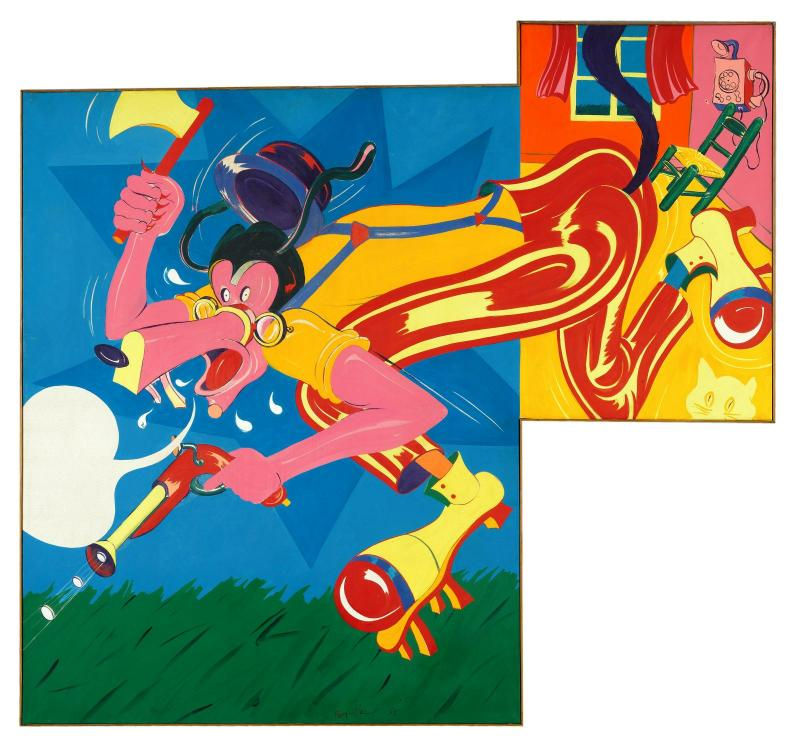What is Nouvelle Figuration?
- jonathan-pradillon

- Jan 19
- 4 min read
Nouvelle Figuration (New Figuration) is an artistic movement that emerged in the 1960s in Europe and America, marking a return to figurative representation in a period dominated by abstraction. This movement stands out for its critical and engaged approach, addressing social, political, and existential themes through impactful and visually bold works. It reflects a desire to reconnect art with human realities while breaking away from the traditional codes of classical figuration.

Origins and Historical Context
Nouvelle Figuration emerged during a pivotal moment in art history, as artists increasingly sought to go beyond the limits imposed by the abstract and informal art that had dominated after World War II. At the time, abstract works, despite being revolutionary, were criticized for their sometimes hermetic nature and detachment from social and cultural concerns.
The societal upheavals of the 1960s played a key role in the rise of this movement. The era was marked by significant transformations: the rise of consumer culture, increasing media influence, civil rights struggles, wars, and political crises. These changes drove artists to reintroduce the human figure but in a novel form, often characterized by distortions, exaggerations, and vibrant colors. Nouvelle Figuration became a way to express the tensions of this era while challenging established aesthetic norms.
In this context, several European artists, particularly in France and Italy, along with American creators, united around the idea of reinventing figuration without returning to academic realism. Their works, though figurative, incorporated influences such as Expressionism, Pop Art, and Surrealism.
Key Characteristics
A Reimagined, Engaged Human Figure
The human figure is central to Nouvelle Figuration but diverges from idealized depictions of classical art. Bodies are often distorted, exaggerated, or placed in absurd contexts, reflecting the anxieties and contradictions of the modern era. Artists use the human form to explore the tension between individual experience and societal pressures. Expressive faces, dramatic gestures, and unsettling scenes convey deep reflections on human identity in a changing world.
Critique of Contemporary Society
One defining trait of Nouvelle Figuration is its critical lens on modern society. Artists denounce the excesses of consumer culture, the cultural standardization imposed by the media, and growing social inequalities. Works also tackle themes such as alienation, conformity, and the loss of individuality. Through striking compositions, artists invite viewers to reflect on their role in an often oppressive economic and political system.
For instance, Bernard Rancillac’s paintings, with their bold colors and graphic style, directly reference the influence of advertising and media imagery. Yet, rather than merely reflecting these mechanisms, his works offer a subtle, sometimes ironic critique of their alienating effects.
A Fusion of Artistic Styles
Nouvelle Figuration is not a uniform movement. Artists associated with it adopt diverse approaches, borrowing elements from various artistic currents. Pop Art influences their exploration of themes tied to popular culture and media, yet Nouvelle Figuration is often darker and more critical. The movement also integrates Expressionist elements, emphasizing raw emotion and distortion, as well as Surrealist inspirations, playing with dreams and absurdity to unsettle the viewer.
Major Figures of Nouvelle Figuration
Francis Bacon
Though not directly associated with Nouvelle Figuration, Francis Bacon embodies its spirit through his haunting and visceral depictions of the human condition. His works, where bodies appear caught in existential tension, reflect a universal angst about absurdity and the fragility of existence.
Bernard Rancillac
Rancillac is one of France’s emblematic figures in the movement. His works blend Pop Art aesthetics with sharp social critique. He incorporates references to media, advertisements, and mass culture imagery to question the mechanisms of manipulation and cultural homogenization.
Valerio Adami
Italian artist Valerio Adami is known for his vibrant, outlined compositions that resemble stained glass or comic book panels. His paintings explore philosophical and political questions through carefully structured arrangements.
Erró
Icelandic artist Erró stands out for his visual collages saturated with imagery borrowed from comics, advertising, and newspapers. His works often serve as an acerbic critique of consumerism and media manipulation, highlighting the overload of information and stimuli in contemporary society.
Legacy and Contemporary Relevance of Nouvelle Figuration
Nouvelle Figuration has left a lasting mark on contemporary art. By reintroducing the human figure in an innovative and engaged way, it paved the way for artists seeking to merge visual storytelling with formal experimentation. Its influence can be seen in current practices that address tensions between the individual and society, particularly in a world marked by political, ecological, and identity crises.
Today, contemporary artists revisit the themes of Nouvelle Figuration, especially by exploring the impacts of digital technologies, social media, and new forms of alienation in a globalized society. Thus, this movement remains a point of reference for those creating art that is both accessible, critical, and visually striking.
FAQ
What is Nouvelle Figuration?
Nouvelle Figuration is an artistic movement from the 1960s that places the human figure at the center of creation while incorporating social critique and modern innovations.
What themes are explored in this movement?
Consumer culture, media, politics, social inequality, and existential crises are central themes.
What are the primary influences on Nouvelle Figuration?
Pop Art, Expressionism, and Surrealism are significant influences, integrated into a unique and engaged visual language.
Who are the key artists of the movement?
Francis Bacon, Bernard Rancillac, Valerio Adami, and Erró are some of the most influential figures.
Why is Nouvelle Figuration still relevant today?
With its critical perspective and bold visual language, Nouvelle Figuration continues to inspire artists exploring contemporary social and cultural issues.



Comments